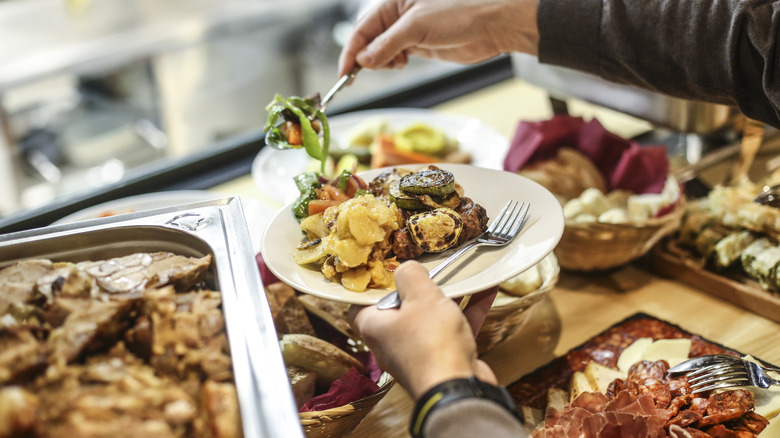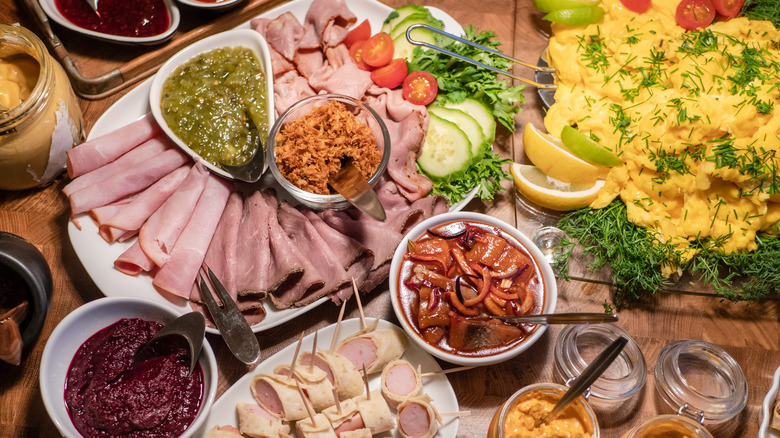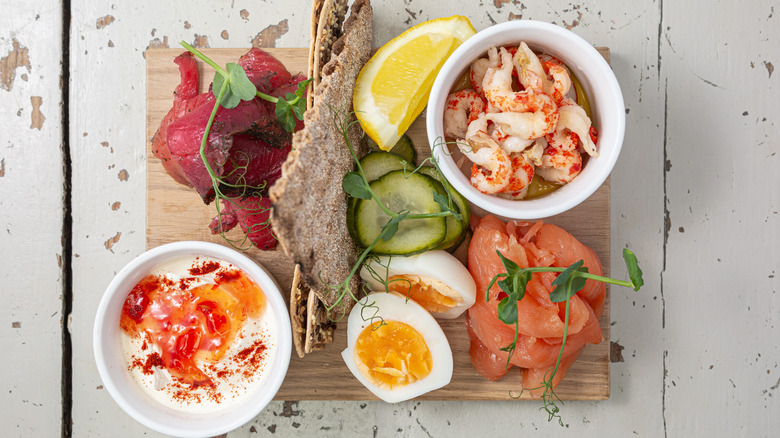How A Smörgåsbord Differs From A Regular Buffet
"Smörgåsbord" is not only fun to say, but even more enjoyable to experience. If you've had the pleasure of visiting a classic smörgåsbord restaurant in Pennsylvania Dutch country, you'll know it means a buffet-style spread of both hot and cold food. A prime example is Shady Maple Smorgasbord in Lancaster County, one of the largest buffets in the United States, featuring a 200-foot-long table brimming with pickled, cured, smoked, fried, and roasted items. However, there's a significant difference between this Americanized buffet and its Scandinavian origin.
While both concepts embrace variety, the traditional buffet tends to focus on larger portions, whereas the smörgåsbord promotes a more nosh-sized dining style. It's akin to the difference between sampling appetizers and loading up on mains. As such, a smörgåsbord meal can last for hours, filled with chatting, singing, and drinking, interspersed with all the glorious snacking. This social aspect is a key feature of the culinary tradition, making it all the more precious.
A classic Scandinavian spread
The smörgåsbord traces its origins to Sweden — in fact, the Swedish term roughly translates to "buttered table." This name is more understandable when considering that it originally referred to a pre-dinner meal featuring bread, butter, cold protein, and aquavit (a caraway-flavored schnapps). First appearing in the grand homes of 16th-century Swedish society, diners would gather around the smörgåsbord table, sipping aquavit and enjoying small plates of cured fish, bread, and pickled accompaniments while waiting for the more formal dinner. The dishes, complementing the spiced schnapps, often featured dill, caraway, fennel, coriander, and other classic flavors. Eventually, the smörgåsbord evolved from a dinner introduction to the main meal.
Given its Nordic origins, it's unsurprising that the menu often includes classic dishes from the region, such as pickled herring, gravlax, and glazed Swedish meatballs. The traditional meal comes with certain unspoken rules: Cold items should not be mixed on the same plate as hot ones. Diners typically start with pickled herring and cured fish, then move on to other proteins like cold cuts or hard boiled eggs. Next, they proceed to hot items like meatballs and potato casseroles, finishing with dessert and coffee. Throughout the meal, schnapps, preferably aquavit, and beer are essential accompaniments.
The smörgåsbord comes to America
There are two distinct ways the smörgåsbord was introduced to America: one through the Pennsylvania Dutch community, and the other by the Swedes themselves. Starting with the Pennsylvania Dutch, this community came to the United States beginning in 1683, bringing significant culinary traditions, including a variation of the smörgåsbord-style buffet. Today, this buffet showcases American abundance rather than traditional Swedish dishes — you'll find steak, french fries, and mac and cheese at places like Shady Maple Smorgasbord.
A more traditional smörgåsbord was introduced by the Swedes at the 1939 World's Fair in Flushing, Queens. It went on to become a sensation in the restaurant scene from around 1940 to 1960, emerging as a popular concept in various locations from Miami, Florida to Belleville, Ohio. This version also evolved into a buffet-style, with diners loading large amounts of food onto one plate, rather than opting for small, organized plates. Today, more authentic smörgåsbords can be found in areas like New York, where Aquavit restaurant serves a holiday version (known as Julbord) in December. However, creating your own smörgåsbord at home is still the easiest option. All you need are some Scandinavian culinary classics and a big, hungry crowd.



